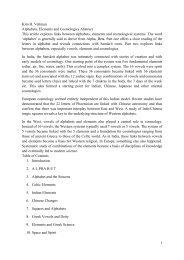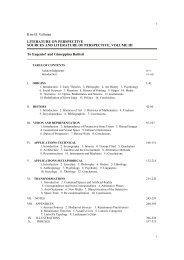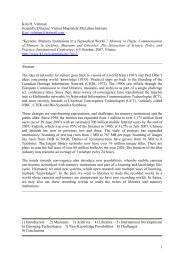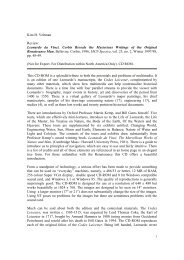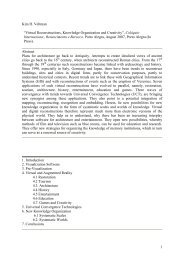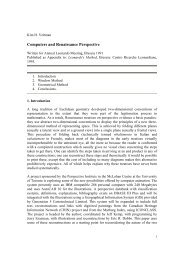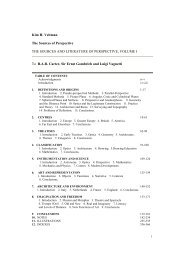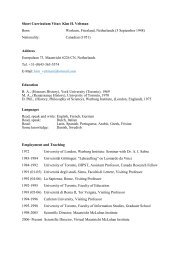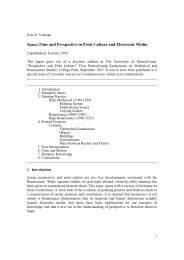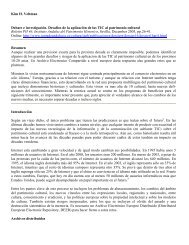1986 Perspective, Anamorphosis And Vision
1986 Perspective, Anamorphosis And Vision
1986 Perspective, Anamorphosis And Vision
You also want an ePaper? Increase the reach of your titles
YUMPU automatically turns print PDFs into web optimized ePapers that Google loves.
ecoming mechanical copiers of nature. Indeed it led gradually to a distinction between<br />
technical drawing and what we now term „fine art".<br />
Paradoxically, the projection principles of perspective had an effect that was the reverse<br />
of taking away the artists' freedom. <strong>Perspective</strong> introduced new possibilities of playing<br />
with forms, not only in the natural world but equally in the mind.<br />
The most famous examples of Renaissance perspective all involve idealized places, new<br />
fictions of the mind, rather than photographic-like copies of street scenes of actual places:<br />
e.g. the Baltimore, Berlin and Urbino panels (figs. 2-5), Piero's „Flagellation" (fig. 1),<br />
Leonardo's Last Supper, or the Annunciation scenes of Masolino, Domenico Veneziano,<br />
Fra Angelico, Fra Filippo Lippi, Vincenzo Foppa, Carlo Crivelli or Raphael's School of<br />
Athens.<br />
The Renaissance masters knew that they were not bound to the monotony of geometrical<br />
lines imposed by regular man-made objects. Leonardo explored such lines in his Uffizi<br />
study of the Adoration, but left them aside in his later version. After 1497 he abandoned<br />
man made objects altogether. Hence the Mona Lisa, the Virgin and St. Anne, the Bacchus<br />
and St. John have no constraining vanishing points. His successors followed suit.<br />
During the Renaissance there evolved links between theories of vision, projection and<br />
representation. These links led some thinkers to recognize that here were clear<br />
distinctions to be made between subjective theories of vision and objective methods of<br />
projection. In this matter, lesser thinkers were less clear, whence the historical realities<br />
are more complex than Panofsky's assumptions allowed him to see.<br />
Neo-Kantians may be disappointed, but they ought not to be. Such complexities of history<br />
confirm that every discovery of new laws and rules, inspires new exceptions thereto. That<br />
is why the discovery of laws of perspective and anamorphosis is a chapter in the<br />
discovery of human freedom.<br />
21



